Exploring Equity in Public Transportation Planning Using Smart Card Data
Abstract
1. Introduction
2. Background
2.1. Equity in PT Planning
- Temporal equity: equitable access to transport services considering the time-critical nature of accessibility needs [24], such as transport accessibility for users with low trip frequency or high trip frequency (regular users) during peak-hour or off-peak-hour.
2.2. Smart Card Data Application in PT Planning
3. Material and Method
3.1. Data and Study Area
3.2. Data Analysis Method
- 1.1.
- Extracting data from SQL server of KMM;
- 1.2.
- Converting extracted data to daily basis Excel file;
- 2.1.
- Identifying the data without coordination information;
- 2.2.
- Identifying the data with false coordination information;
- 2.3.
- Modifying data coordination information according to General Transit Feed Specification (GTFS) data coordination (PT schedules and associated geographic information provided by Google);
- 2.4.
- Categorizing card holders into six user groups with similar characteristics to come across more meaningful analysis.
- 3.1.
- Filtering the dataset based on ID numbers;
- 3.2.
- Extracting the following information for each ID (card holder) and add to ID dataset: daily number of boarding, trip-day information (which day and total number of days in 1 month), and card type. This refers to the calculation of group characteristics of each cardholder ID per day (frequency of PT use, boarding rate per workdays and weekends) and the calculation of its average values per user (including the average frequency of use and boardings per workday etc.);
- 3.3.
- Clustering natural cardholder groups according to their average values;
- 3.4.
- Clustering cardholder frequency groups (30 groups according to number of day that cardholder used PT);
- 3.5.
- Creating PT route-based dataset and extracting the boarding data of bus routes.
- 4.1.
- CARD ID-based data analysis and filtering
- 4.1.1.
- Identifying both workday (weekday) trips and weekend trips in ID-based dataset, and assign a dummy variable value (0 and 1) to them;
- 4.1.2.
- Identifying the number of days commuted by every card holder ID in entire dataset, determine the average daily trips, average monthly trips, and their standard deviation (STD);
- 4.1.3.
- Identifying the workday trips by every card holder ID, in entire dataset, determine the average daily trips, average monthly trips, and their STD;
- 4.1.4.
- Identifying the weekend trips by every card holder ID, in entire dataset, determine the average daily trips, average monthly trips, and their STD;
- 4.1.5.
- Identifying the number of days commuted by PT based on the day commuted (all days, workday, and weekend) and modified user groups (6 clustered user groups), determining the average daily trips, average monthly trips, and their STD.
- 4.2.
- PT Route-based data analysis and filtering
- 4.2.1.
- Filter the data based on PT routes;
- 4.2.2.
- For each PT route, identify the workday trips and weekend trips in entire ID dataset, and assign a dummy variable value (0 and 1) to them;
- 4.2.3.
- For each PT route, identify the number of days commuted by every card holder ID in entire dataset, determine the average daily trips, average monthly trips, and their STD;
- 4.2.4.
- For each PT route, identify the workday trips by every card holder ID in entire data set, determine the average daily trips, average monthly trips, and their STD;
- 4.2.5.
- For each PT route, identify the weekend trips by every card holder ID in entire dataset, determine the average daily trips, average monthly trips, and their STD;
- 4.2.6.
- For each PT route, identify the number of days commuted based on the day commuted (all days, workday, and weekend) and modified user groups (i.e., six similar card holder groups), determine the average daily trips, average monthly trips, and their STD.
- WD: notation for weekday or weekend/holiday; whether the day of boarding (boarding) is weekend or holiday; WD = 0, else WD = 1;
- SCg,i,WD: number of card holder of group “g”, which have boarding in “i” days in weekday or weekend/holiday;
- TCg,i,WD: number of boarding of card holder of group “g”, which have boarding in “i” days in weekday or weekend/holiday;
- n: number of days; for 1 month, n = 30; for weekday, n = 21; and for weekend, n = 9.
4. Results and Discussions
4.1. Group Categorization Analysis
4.2. Monthly’s Trip-Frequency Analysis on User Groups
4.3. Workdays’ Trip-Frequency Analysis on User Groups
4.4. Bus Line-Based Analysis on Workday Trips
- Bus lines no. 118 and 23 have on average 6348 and 6802 boarding per workday, respectively.
- Average daily card holder numbers of these lines are 5014 and 5531 per workday, respectively.
- The total number of card holders per workdays are 38,628 and 45,921 for bus lines no. 118 and no. 23, respectively.
5. Conclusions
5.1. Research Highlights
- Card holders who have a 1–day boarding frequency represent 66% of the whole dataset, while they represent 22% in a single workday.
- Card holders with a 16–21 days boarding frequency represent 16% of the whole dataset, while they represent 39% in 1 workday.
- Regular users also have a higher boarding rate per day and will be much more overrepresented in single-day data.
- The elderly, those with disabilities, the elderly and disabled: in terms of the average number of boardings, elderly card holders (group 3), and PwD card holders (group 4) have higher (c. 10–15%) boarding rates on weekdays and weekends compared to other card holder groups. This shows that these users need more travel access. Another finding shows that PT routes and lines are not planned based on their travel needs (medical centers, elderly house, organizations for PwD, etc.), consequently, this increases their number of transfers between lines.
- Some trip routes are used by more people, even though the number of users is rarer on a daily basis, such as PT routes to medical centers (medical trips).
- Since the smart card data are boarding (transaction) based, more boardings may not really mean more trips. In other words, more boardings are likely to result from more transfer due to PT network limitations.
- Monthly users and boarding frequencies, instead of daily data, can be examined in public transportation planning, investments, improvements, and evaluated as a performance criterion.
- Travel behavior and mobility pattern of PT users varies on weekends compared to workdays due to reduced PT vehicles’ frequency (headway) and reduced number of active PT lines.
5.2. Limitations and Directions for Further Studies
- We proposed a novel approach using 1-month data, which can be paved the way for further studies using long-period data like yearly dataset.
- Some users use different cards or a card belong to somebody else (e.g., family members, relatives, or friends) as there is no card control (verification) or enforcement system in KMM’s PT network. Moreover, some PT users do not have a smart card or enough charge while boarding, consequently, they have to use the driver’s card or other passengers’ cards. Thus, one of the limitations of our study is the possibility of the mis-grouping of those users having low boarding frequency. This issue needs further development in the proposed method.
- It can be seen that the elderly and PwD have significantly higher boarding rates on weekdays and weekends. Using the PT boarding data for OD estimation, one may study whether this boarding rate is due to their high travel tendency or the transfer between bus lines. If it was due to their high transfer rate between the bus lines, it means transport infrastructure is not designed/planned based on vulnerable users’ group.
- In this study, 1-month PT-SCFC data has been used to analyze the travel behavior of users. The study can be extended using more than 1-month data or 1-year data to include the effects of holidays, summer seasons, etc. on the travel behavior of PT users.
- A simple and effective statistical analysis was conducted to come to the research hypothesis; however, advanced data analysis techniques could be employed to improve the proposed methodology. More advanced analyses may reveal more details about the nature of the phenomenon.
Author Contributions
Funding
Data Availability Statement
Acknowledgments
Conflicts of Interest
Appendix A
| Trip Freq. Group | # of Days Which Users Have a Min. 1 Boarding | Share of Card Holder | Share of Boarding | Number of Card Holders | Share of Card holders in Entir Dataset | Avg. Boarding Per Card Holder |
|---|---|---|---|---|---|---|
| 1-day | 212,901 | 3.5% | 2.7% | 212,901 | 26.3% | 1.57 |
| 2-days | 192,544 | 3.2% | 2.9% | 96,272 | 11.9% | 1.87 |
| 3-days | 210,165 | 3.5% | 3.2% | 70,055 | 8.7% | 1.88 |
| 4-days | 214,556 | 3.6% | 3.3% | 53,639 | 6.6% | 1.90 |
| 5-days | 211,370 | 3.5% | 3.3% | 42,274 | 5.2% | 1.91 |
| 6-days | 205,074 | 3.4% | 3.2% | 34,179 | 4.2% | 1.92 |
| 7-days | 197,015 | 3.3% | 3.1% | 28,145 | 3.5% | 1.92 |
| 8-days | 188,800 | 3.1% | 3.0% | 23,600 | 2.9% | 1.94 |
| 9-days | 176,418 | 2.9% | 2.8% | 19,602 | 2.4% | 1.95 |
| 10-days | 172,460 | 2.9% | 2.7% | 17,246 | 2.1% | 1.95 |
| 11-days | 164,780 | 2.7% | 2.6% | 14,980 | 1.9% | 1.96 |
| 12-days | 162,276 | 2.7% | 2.6% | 13,523 | 1.7% | 1.98 |
| 13-days | 158,288 | 2.6% | 2.6% | 12,176 | 1.5% | 1.98 |
| 14-days | 158,466 | 2.6% | 2.6% | 11,319 | 1.4% | 1.98 |
| 15-days | 159,615 | 2.6% | 2.6% | 10,641 | 1.3% | 2.00 |
| 16-days | 168,112 | 2.8% | 2.7% | 10,507 | 1.3% | 2.00 |
| 17-days | 177,548 | 2.9% | 2.9% | 10,444 | 1.3% | 2.01 |
| 18-days | 196,038 | 3.2% | 3.2% | 10,891 | 1.3% | 2.01 |
| 19-days | 216,201 | 3.6% | 3.6% | 11,379 | 1.4% | 2.02 |
| 20-days | 251,860 | 4.2% | 4.2% | 12,593 | 1.6% | 2.04 |
| 21-days | 317,583 | 5.3% | 5.3% | 15,123 | 1.9% | 2.05 |
| 22-days | 304,788 | 5.0% | 5.2% | 13,854 | 1.7% | 2.09 |
| 23-days | 295,688 | 4.9% | 5.1% | 12,856 | 1.6% | 2.12 |
| 24-days | 273,936 | 4.5% | 4.8% | 11,414 | 1.4% | 2.16 |
| 25-days | 268,800 | 4.5% | 4.8% | 10,752 | 1.3% | 2.18 |
| 26-days | 242,554 | 4.0% | 4.4% | 9329 | 1.2% | 2.24 |
| 27-days | 189,945 | 3.1% | 3.5% | 7035 | 0.9% | 2.26 |
| 28-days | 149,324 | 2.5% | 2.8% | 5333 | 0.7% | 2.33 |
| 29-days | 114,057 | 1.9% | 2.2% | 3933 | 0.5% | 2.39 |
| 30-days | 85,200 | 1.4% | 1.8% | 2840 | 0.4% | 2.57 |
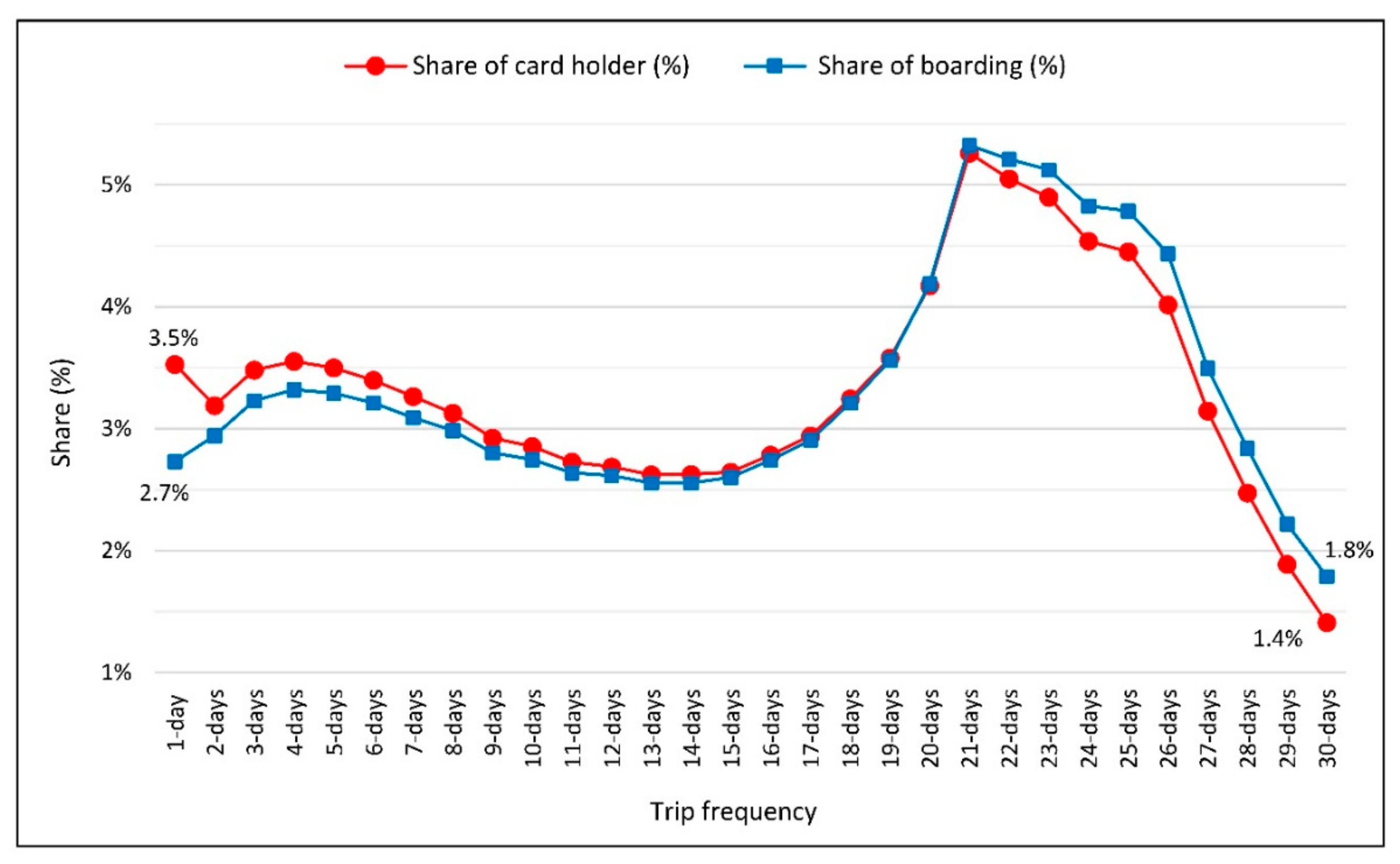
| Monthly Dataset Considered | 1-Day Data Considered | |||||
|---|---|---|---|---|---|---|
| Trip-Frequency Group | # of Boarding | # of Persons | Share of Boarding Per Workday | Real Share of Persons in Entire Dataset | Average Daily Boarding | Average Daily Persons |
| 1-day | 324,499 | 199,101 | 3.4% | 27.7% | 3.4% | 4.3% |
| 2-days | 349,716 | 93,754 | 3.7% | 13.1% | 3.7% | 4.0% |
| 3-days | 367,098 | 65,030 | 3.9% | 9.1% | 3.9% | 4.2% |
| 4-days | 364,439 | 47,898 | 3.8% | 6.7% | 3.8% | 4.1% |
| 5-days | 355,237 | 36,995 | 3.7% | 5.2% | 3.7% | 4.0% |
| 6-days | 331,553 | 28,614 | 3.5% | 4.0% | 3.5% | 3.7% |
| 7-days | 315,060 | 23,289 | 3.3% | 3.2% | 3.3% | 3.5% |
| 8-days | 307,429 | 19,625 | 3.2% | 2.7% | 3.2% | 3.4% |
| 9-days | 297,678 | 16,887 | 3.1% | 2.4% | 3.1% | 3.3% |
| 10-days | 294,019 | 14,819 | 3.1% | 2.1% | 3.1% | 3.2% |
| 11-days | 283,139 | 13,075 | 3.0% | 1.8% | 3.0% | 3.1% |
| 12-days | 283,032 | 11,881 | 3.0% | 1.7% | 3.0% | 3.1% |
| 13-days | 298,710 | 11,421 | 3.1% | 1.6% | 3.1% | 3.2% |
| 14-days | 309,643 | 10,970 | 3.3% | 1.5% | 3.3% | 3.3% |
| 15-days | 350,036 | 11,405 | 3.7% | 1.6% | 3.7% | 3.7% |
| 16-days | 398,111 | 12,002 | 4.2% | 1.7% | 4.2% | 4.1% |
| 17-days | 464,997 | 13,113 | 4.9% | 1.8% | 4.9% | 4.8% |
| 18-days | 564,845 | 14,880 | 5.9% | 2.1% | 5.9% | 5.7% |
| 19-days | 699,227 | 17,351 | 7.4% | 2.4% | 7.4% | 7.1% |
| 20-days | 966,314 | 22,257 | 10.2% | 3.1% | 10.2% | 9.5% |
| 21-days | 1,572,397 | 33,214 | 16.6% | 4.6% | 16.6% | 15.0% |
| Trip Freq. Group | 1 Normal | 2 Student | 3 Elderly | 4 PwD | 5 Limited-Use | 6 Others | ||||||
|---|---|---|---|---|---|---|---|---|---|---|---|---|
| Board. | Person | Board. | Person | Board. | Person | Board. | Person | Board. | Person | Board. | Person | |
| 1-day | 5.44% | 5.77% | 1.08% | 1.28% | 2.73% | 3.37% | 1.65% | 2.12% | 98.38% | 98.70% | 2.42% | 2.89% |
| 2-days | 6.79% | 6.98% | 1.32% | 1.57% | 4.01% | 4.78% | 2.48% | 3.08% | 1.30% | 1.08% | 3.26% | 3.72% |
| 3-days | 6.87% | 7.06% | 1.44% | 1.67% | 4.79% | 5.54% | 3.00% | 3.57% | 0.22% | 0.17% | 3.68% | 4.13% |
| 4-days | 6.56% | 6.69% | 1.50% | 1.71% | 5.34% | 5.98% | 3.26% | 3.82% | 0.02% | 0.02% | 3.94% | 4.33% |
| 5-days | 6.12% | 6.21% | 1.57% | 1.77% | 5.50% | 6.08% | 3.44% | 3.90% | 0.00% | 0.00% | 4.11% | 4.45% |
| 6-days | 5.44% | 5.51% | 1.62% | 1.81% | 5.32% | 5.77% | 3.44% | 3.82% | 0.00% | 0.00% | 3.94% | 4.23% |
| 7-days | 4.84% | 4.89% | 1.67% | 1.88% | 5.59% | 6.00% | 3.76% | 4.14% | 0.00% | 0.00% | 3.77% | 4.04% |
| 8-days | 4.36% | 4.36% | 1.93% | 2.14% | 5.20% | 5.42% | 3.64% | 3.95% | 0.00% | 0.00% | 3.93% | 4.14% |
| 9-days | 3.98% | 4.02% | 2.08% | 2.27% | 5.01% | 5.13% | 3.62% | 3.86% | 0.00% | 0.00% | 3.65% | 3.85% |
| 10-days | 3.71% | 3.74% | 2.22% | 2.37% | 4.91% | 4.91% | 3.72% | 3.88% | 0.00% | 0.00% | 3.64% | 3.81% |
| 11-days | 3.43% | 3.50% | 2.28% | 2.45% | 4.61% | 4.63% | 3.67% | 3.83% | 0.00% | 0.00% | 3.41% | 3.55% |
| 12-days | 3.16% | 3.23% | 2.53% | 2.67% | 4.33% | 4.30% | 3.50% | 3.56% | 0.00% | 0.00% | 3.54% | 3.68% |
| 13-days | 3.13% | 3.17% | 2.90% | 3.01% | 4.23% | 4.12% | 3.93% | 3.94% | 0.00% | 0.00% | 3.52% | 3.62% |
| 14-days | 3.07% | 3.13% | 3.32% | 3.40% | 3.67% | 3.47% | 3.81% | 3.91% | 0.00% | 0.00% | 3.40% | 3.53% |
| 15-days | 3.23% | 3.27% | 4.02% | 4.04% | 3.86% | 3.67% | 4.17% | 4.05% | 0.00% | 0.00% | 3.70% | 3.79% |
| 16-days | 3.42% | 3.43% | 4.87% | 4.84% | 3.92% | 3.60% | 4.22% | 4.10% | 0.08% | 0.04% | 4.41% | 4.39% |
| 17-days | 3.60% | 3.62% | 6.11% | 5.99% | 3.80% | 3.50% | 4.70% | 4.77% | 0.00% | 0.00% | 5.50% | 5.40% |
| 18-days | 4.05% | 3.93% | 7.92% | 7.79% | 4.03% | 3.66% | 5.34% | 5.10% | 0.00% | 0.00% | 5.73% | 5.63% |
| 19-days | 4.63% | 4.48% | 10.40% | 10.19% | 4.12% | 3.63% | 6.24% | 5.97% | 0.00% | 0.00% | 6.17% | 5.87% |
| 20-days | 5.62% | 5.30% | 14.95% | 14.39% | 5.68% | 4.89% | 9.05% | 8.38% | 0.00% | 0.00% | 8.69% | 7.82% |
| 21-days | 8.55% | 7.69% | 24.25% | 22.76% | 9.35% | 7.52% | 19.36% | 16.27% | 0.00% | 0.00% | 15.60% | 13.13% |
| Date of November 2018 | 1 | 2 | 3 | 4 | 5 | 6 | 7 | 8 | 9 | 10 | 11 | 12 | 13 | 14 | 15 |
| Share of boarding (trip) | 7% | 5% | 5% | 5% | 6% | 9% | 9% | 5% | 4% | 4% | 5% | 5% | 8% | 9% | 5% |
| Date of November 2018 | 16 | 17 | 18 | 19 | 20 | 21 | 22 | 23 | 24 | 25 | 26 | 27 | 28 | 29 | 30 |
| Share of boarding (trip) | 4% | 5% | 5% | 6% | 8% | 9% | 5% | 5% | 5% | 5% | 7% | 9% | 10% | 10% | 9% |
References
- Banister, D. The sustainable mobility paradigm. Transp. Policy 2008, 15, 73–80. [Google Scholar] [CrossRef]
- OECD Improving Transport Accessibility for All: Guide to Good Practice; European Conference of Ministers of Transport (ECMT) Publications: Paris, France, 2006; ISBN 9282101398.
- Dadashzadeh, N.; Ergun, M. Spatial bus priority schemes, implementation challenges and needs: An overview and directions for future studies. Public Transp. 2018, 10, 545–570. [Google Scholar] [CrossRef]
- Dadashzadeh, N. Effects of Bus PRIORITY Methods on Adjacent Mixed Traffic; Istanbul Technical University: Istanbul, Turkey, 2019. [Google Scholar]
- Beyazit, E. Evaluating Social Justice in Transport: Lessons to be Learned from the Capability Approach. Transp. Rev. 2011, 31, 117–134. [Google Scholar] [CrossRef]
- Vanoutrive, T.; Cooper, E. How just is transportation justice theory? The issues of paternalism and production. Transp. Res. Part A Policy Pract. 2019, 122, 112–119. [Google Scholar] [CrossRef]
- Martens, K. Transport Justice: Designing Fair Transportation Systems; Routledge Taylor & Francis Group: New York, NY, USA, 2017; ISBN 9780415638319. [Google Scholar]
- Di Ciommo, F.; Shiftan, Y. Transport equity analysis. Transp. Rev. 2017, 37, 139–151. [Google Scholar] [CrossRef]
- Kelobonye, K.; Zhou, H.; McCarney, G.; Xia, J. Measuring the accessibility and spatial equity of urban services under competition using the cumulative opportunities measure. J. Transp. Geogr. 2020, 85, 102706. [Google Scholar] [CrossRef]
- Martens, K.; Di Ciommo, F. Travel time savings, accessibility gains and equity effects in cost–benefit analysis. Transp. Rev. 2017, 37, 152–169. [Google Scholar] [CrossRef]
- Martens, K. Substance precedes methodology: On cost-benefit analysis and equity. Transportation 2011, 38, 959–974. [Google Scholar] [CrossRef]
- Koutsopoulos, H.N.; Ma, Z.; Noursalehi, P.; Zhu, Y. Transit Data Analytics for Planning, Monitoring, Control, and Information. In Mobility Patterns, Big Data and Transport Analytics; Antoniou, C., Dimitriou, L., Pereira, F., Eds.; Elsevier B.V.: Amsterdam, The Netherlands, 2018; ISBN 9780128129708. [Google Scholar]
- Yu, W.; Bai, H.; Chen, J.; Yan, X. Anomaly Detection of Passenger OD on Nanjing Metro Based on Smart Card Big Data. IEEE Access 2019, 7, 138624–138636. [Google Scholar] [CrossRef]
- Zhang, X.; Wang, Q. PeopleVis: A visual analysis system for mining travel behavior. In Proceedings of the 2017 IEEE 21st International Conference on Computer Supported Cooperative Work in Design, Wellington, New Zealand, 26–28 April 2017; pp. 463–468. [Google Scholar]
- Lee, I. Estimating of Bus-Trip Destinations Using Temporal Travel patterns of Smart Card Data. Ph.D. Thesis, Seoul National University, Seoul, Korea, August 2019. [Google Scholar]
- Ali, A.A.; Eliasson, J. Dynamic origin-destination estimation using smart card data: An entropy maximisation approach. arXiv 2019, arXiv:1909.02826. [Google Scholar]
- Alsger, A.; Tavassoli, A.; Mesbah, M.; Ferreira, L.; Hickman, M. Public transport trip purpose inference using smart card fare data. Transp. Res. Part C Emerg. Technol. 2018, 87, 123–137. [Google Scholar] [CrossRef]
- Yu, C.; He, Z.C. Analysing the spatial-temporal characteristics of bus travel demand using the heat map. J. Transp. Geogr. 2017, 58, 247–255. [Google Scholar] [CrossRef]
- Tavassoli, A.; Mesbah, M.; Hickman, M. Application of smart card data in validating a large-scale multi-modal transit assignment model. Public Transp. 2018, 10, 1–21. [Google Scholar] [CrossRef]
- Litman, T. Social Inclusion as A Transport Planning Issue in Canada. In Proceedings of the Transport and Social Exclusion G7 Comparison Seminar; Transport Studies Group of the University of Westminster: London, UK, 2003; pp. 6–20. [Google Scholar]
- Litman, T. Evaluating Transportation Equity: Guidance for Incorporating Distributional Impacts in Transportation Planning. Available online: https://www.vtpi.org/equity.pdf (accessed on 26 April 2021).
- Pereira, R.H.M.; Schwanen, T.; Banister, D. Distributive justice and equity in transportation. Transp. Rev. 2017, 37, 170–191. [Google Scholar] [CrossRef]
- Camporeale, R.; Caggiani, L.; Fonzone, A.; Ottomanelli, M. Quantifying the impacts of horizontal and vertical equity in transit route planning. Transp. Plan. Technol. 2017, 40, 28–44. [Google Scholar] [CrossRef]
- McArthur, J.; Robin, E.; Smeds, E. Socio-spatial and temporal dimensions of transport equity for London’s night time economy. Transp. Res. Part A Policy Pract. 2019, 121, 433–443. [Google Scholar] [CrossRef]
- Boisjoly, G.; Serra, B.; Oliveira, G.; El-Geneidy, A. Inequity in transit: Evaluating public transport distribution through accessibility measurements in São Paulo, Rio de Janeiro, Curitiba and Recife, Brazil. J. Transp. Geogr. 2020, 82, 1–11. [Google Scholar] [CrossRef]
- Palm, M.; Farber, S.; Shalaby, A.; Young, M. Equity Analysis and New Mobility Technologies: Toward Meaningful Interventions. J. Plan. Lit. 2020, 36, 31–45. [Google Scholar] [CrossRef]
- Al-Rashid, M.A.; Goh, H.C.; Harumain, Y.A.S.; Ali, Z.; Campisi, T.; Mahmood, T. Psychosocial barriers of public transport use and social exclusion among older adults: Empirical evidence from Lahore, Pakistan. Int. J. Environ. Res. Public Health 2021, 18, 185. [Google Scholar] [CrossRef]
- Martens, K. Accessibility and potential mobility as a guide for policy action. Transp. Res. Rec. 2015, 2499, 18–24. [Google Scholar] [CrossRef]
- Currie, G. Quantifying spatial gaps in public transport supply based on social needs. J. Transp. Geogr. 2010, 18, 31–41. [Google Scholar] [CrossRef]
- United Nations. Cost Benefit Analysis of Transport Infrastructure Projects; United Nations: Geneva, Switzerland, 2003. [Google Scholar]
- Thomopoulos, N.; Grant-Muller, S.; Tight, M.R. Incorporating equity considerations in transport infrastructure evaluation: Current practice and a proposed methodology. Eval. Program Plann. 2009, 32, 351–359. [Google Scholar] [CrossRef] [PubMed]
- Topuz Kiremitçi, S. A Model for Accessibility and Affordability in Urban Transportation: Istanbul Case; Istanbul Technical University: Istanbul, Turkey, 2017. [Google Scholar]
- Pelletier, M.P.; Trépanier, M.; Morency, C. Smart card data use in public transit: A literature review. Transp. Res. Part C Emerg. Technol. 2011, 19, 557–568. [Google Scholar] [CrossRef]
- Syarif, M.; Widyawan; Adji, T.B. Big data analytics: Estimation of destination for users of bus rapid transit (brt) public transportation in Jakarta. In Proceedings of the 2019 International Conference of Artificial Intelligence and Information Technology (ICAIIT), Yogyakarta, Indonesia, 13–15 March 2019; pp. 209–214. [Google Scholar]
- Ma, X.; Ji, Y.; Yuan, Y.; Van Oort, N.; Jin, Y.; Hoogendoorn, S. A comparison in travel patterns and determinants of user demand between docked and dockless bike-sharing systems using multi-sourced data. Transp. Res. Part A Policy Pract. 2020, 139, 148–173. [Google Scholar] [CrossRef]
- Zhang, J.; Shen, D.; Tu, L.; Zhang, F.; Xu, C.; Wang, Y.; Tian, C.; Li, X.; Huang, B.; Li, Z. A real-time passenger flow estimation and prediction method for urban bus transit systems. IEEE Trans. Intell. Transp. Syst. 2017, 18, 3168–3178. [Google Scholar] [CrossRef]
- Tian, X.; Zheng, B. Study Group Travel Behaviour Patterns from Large-Scale Smart Card Data. In Proceedings of the 2019 IEEE International Conference on Big Data, Los Angeles, CA, USA, 9–12 December 2019; pp. 1232–1237. [Google Scholar]
- Tian, X.; Zheng, B. Using Smart Card Data to Model Commuters’ Responses Upon Unexpected Train Delays. In Proceedings of the 2019 IEEE International Conference on Big Data, Seattle, WA, USA, 10–13 December 2018; pp. 831–840. [Google Scholar]
- Zhang, J.; Tu, L.; Zhang, F.; Yin, X.; Sun, J.; Chen, H.S.T. Flexible Express Bus Line Planning and Operating Based on Passenger Flow Analysis. In Proceedings of the 2018 21st International Conference on Intelligent Transportation Systems (ITSC), Maui, HI, USA, 4–7 November 2018; pp. 2511–2518. [Google Scholar]
- Dickens, M.; Hughes-Cromwick, M. Leveraging Big Data in the Public Transportation Industry. Available online: https://www.apta.com/wp-content/uploads/Big-Data-Policy-Brief.pdf (accessed on 26 April 2021).
- Basu, A.; Zhao, J.; Koutsopoulos, H.; Mishalani, R. Data-driven customer segmentation and personalized information provision in public transit. In Proceedings of the TransitData 2019: 5th International Workshop and Symposium: Research and Applications on the Use of passive Data from Public Transport, Paris, France, 8–10 July 2019; pp. 2–18. [Google Scholar]
- Espinoza, C.; Munizaga, M.; Bustos, B.; Trépanier, M. Assessing the public transport travel behavior consistency from smart card data. Transp. Res. Procedia 2018, 32, 44–53. [Google Scholar] [CrossRef]
- Benenson, I.; Marinov, M.; Ben-Elia, E. Unexpected flexibility of public transit usage revealed from mining Israel’s smartcard data. In Proceedings of the TransitData 2019: 5th International Workshop and Symposium: Research and Applications on the use of Passive Data from Public Transport, Paris, France, 8–10 July 2019. [Google Scholar]
- Egu, O.; Bonnel, P. Investigating day-to-day variability of transit usage on a multimonth scale with smart card data. A case study in Lyon. Travel Behav. Soc. 2020, 19, 112–123. [Google Scholar] [CrossRef]
- Raux, C.; Ma, T.Y.; Cornelis, E. Variability in daily activity-travel patterns: The case of a one-week travel diary. Eur. Transp. Res. Rev. 2016, 26, 8. [Google Scholar] [CrossRef]
- Liu, S.; Yamamoto, T.; Yao, E.; Nakamura, T. Exploring Travel Pattern Variability of Public Transport Users Through Smart Card Data: Role of Gender and Age. IEEE Trans. Intell. Transp. Syst. 2020, 1–10. [Google Scholar] [CrossRef]
- Morency, C.; Trépanier, M.; Agard, B. Measuring transit use variability with smart-card data. Transp. Policy 2007, 14, 193–203. [Google Scholar] [CrossRef]
- Agard, B. Mining Smart Card Data from an Urban Transit Network. In Encyclopedia of Data Warehousing and Mining, 2nd ed.; IGI Global: Hershey, PA, USA, 2011; pp. 1292–1302. [Google Scholar]
- Lu, K.; Liu, J.; Zhou, X.; Han, B. A Review of Big Data Applications in Urban Transit Systems. IEEE Trans. Intell. Transp. Syst. 2020, 1–18. [Google Scholar] [CrossRef]
- KMM Kocaeli Province, Turkey. Available online: https://en.wikipedia.org/wiki/Kocaeli_Province (accessed on 13 December 2020).
- Kocaeli Transportation Master Plan and Public Transportation Priority Systems: Updates for 2050; Boğaziçi Proje Engineering Inc.: Kocaeli, Turkey, 2014.
- PTV VISION VISUM: Travel Demand Modeling—User Manuals 2019. Available online: https://www.ptvgroup.com/en/solutions/products/ptv-visum/ (accessed on 14 April 2021).
- Li, T.; Sun, D.; Jing, P.; Yang, K. Smart card data mining of public transport destination: A literature review. Information 2018, 9, 18. [Google Scholar] [CrossRef]
- Smith, G. European medicines agency guideline on bioanalytical method validation: What more is there to say? Bioanalysis 2012, 4, 865–868. [Google Scholar] [CrossRef]
- Gervasi, O.; Murgante, B.; Misra, S.; Garau, C.; Blec, I.; Taniar, D.; Apduhan, B.O.; Maria, A.; Eufemia, A.C.R.; Goos, G. Computational Science and Its Applications—ICCSA 2020; Gervasi, O., Murgante, B., Misra, S., Garau, C., Blečić, I., Taniar, D., Apduhan, B.O., Rocha, A.M.A.C., Tarantino, E., Torre, C.M., Karaca, Y., Eds.; Lecture Notes in Computer Science; Springer International Publishing: Cham, Switzerland, 2020; Volume 12255, ISBN 978-3-030-58819-9. [Google Scholar]
- Torrisi, V.; Garau, C.; Ignaccolo, M.; Inturri, G. “Sustainable Urban Mobility Plans”: Key Concepts and a Critical Revision on SUMPs Guidelines. In Proceedings of the Computational Science and Its Applications—ICCSA 2020; Gervasi, O., Murgante, B., Misra, S., Garau, C., Blečić, I., Taniar, D., Apduhan, B.O., Rocha, A.M.A.C., Tarantino, E., Torre, C.M., et al., Eds.; Springer: Cham, Switzerland, 2020; pp. 613–628. [Google Scholar]
- Pirra, M.; Carboni, A.; Diana, M. Assessing gender gaps in educational provision, research and employment opportunities in the transport sector at the european level. Educ. Sci. 2020, 10, 123. [Google Scholar] [CrossRef]
- Al-Rashid, M.A.; Nahiduzzaman, K.M.; Ahmed, S.; Campisi, T.; Akgün, N. Gender-responsive public transportation in the Dammam metropolitan region, Saudi Arabia. Sustainability 2020, 12, 9068. [Google Scholar] [CrossRef]
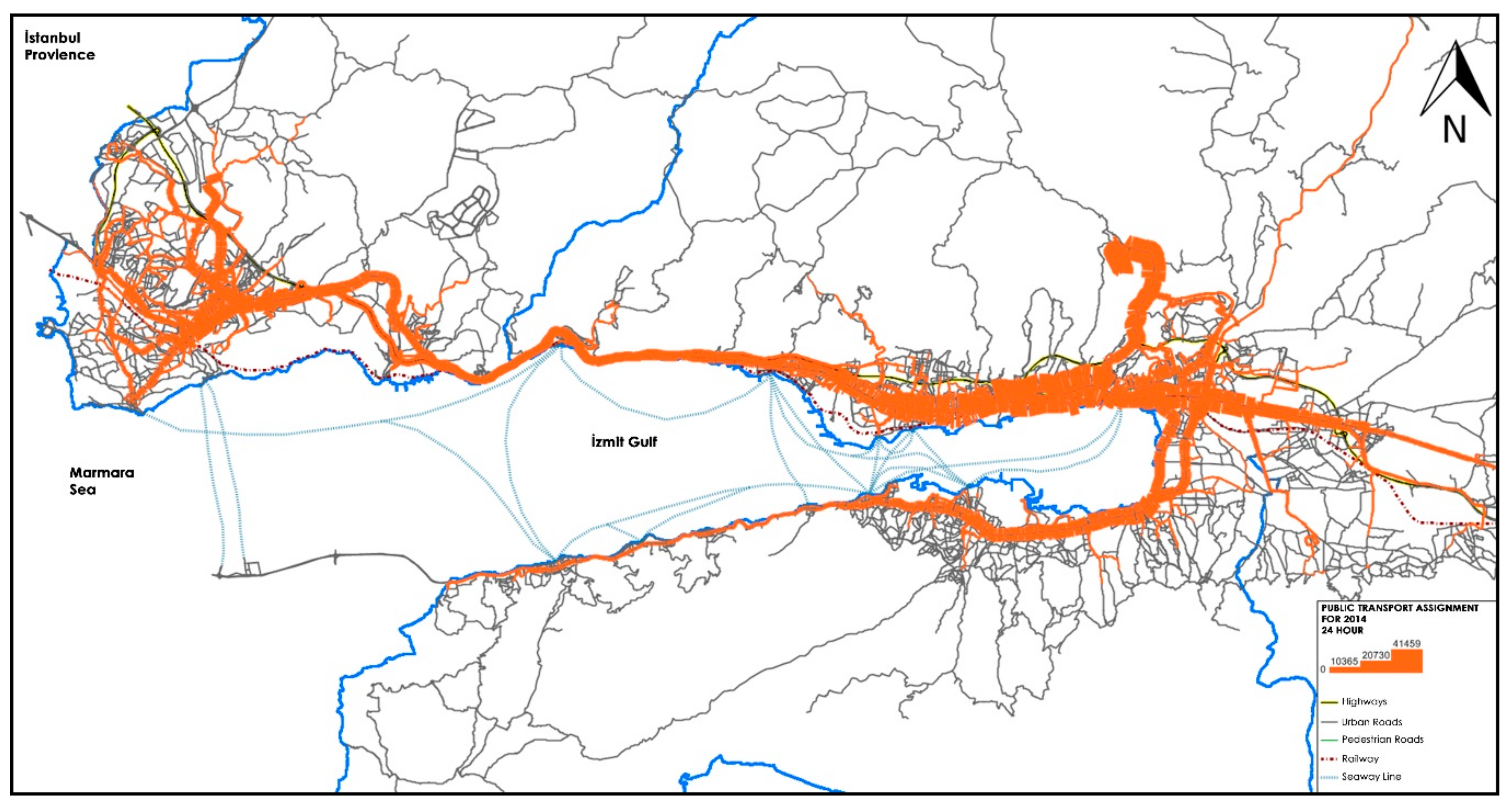
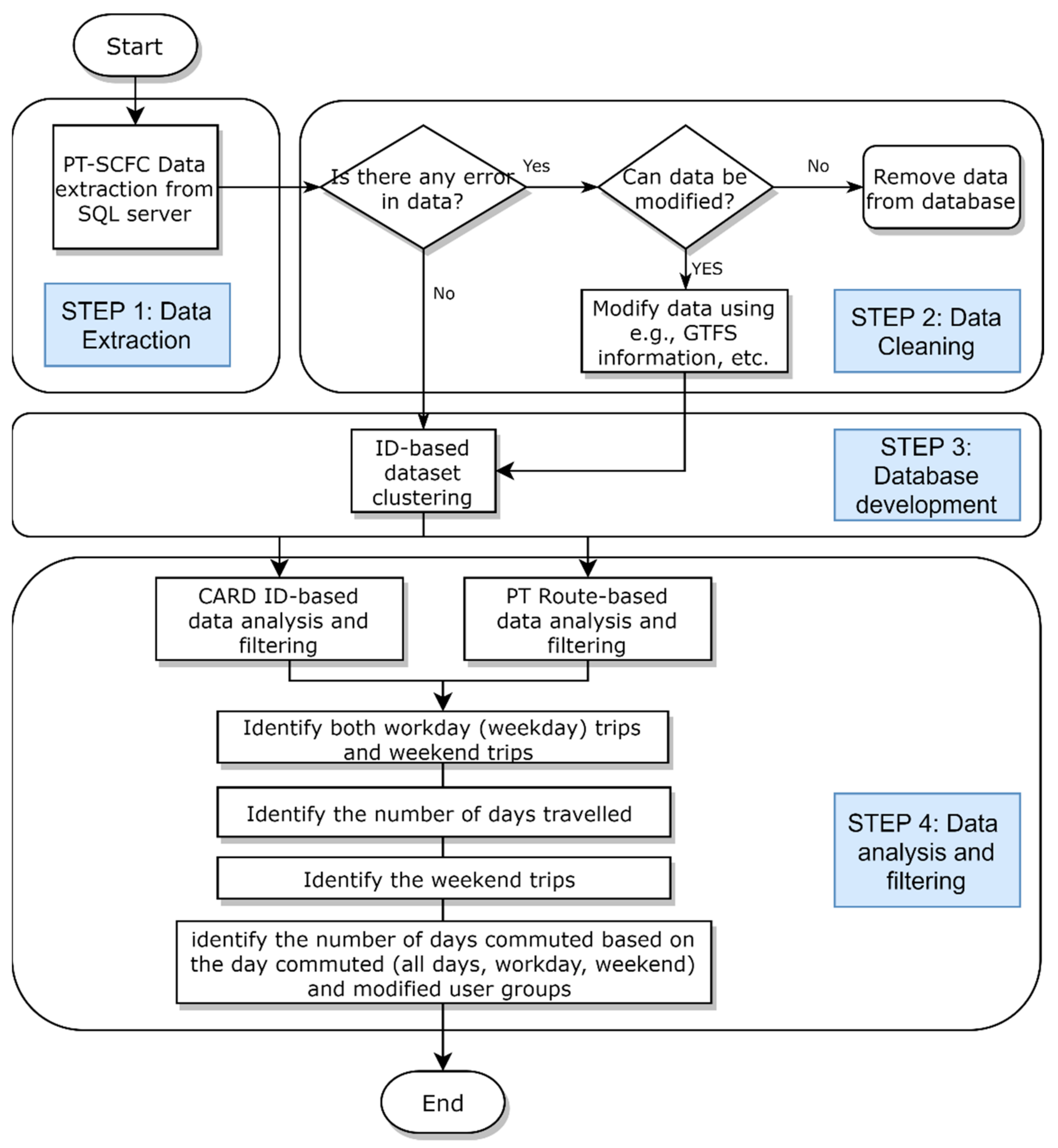
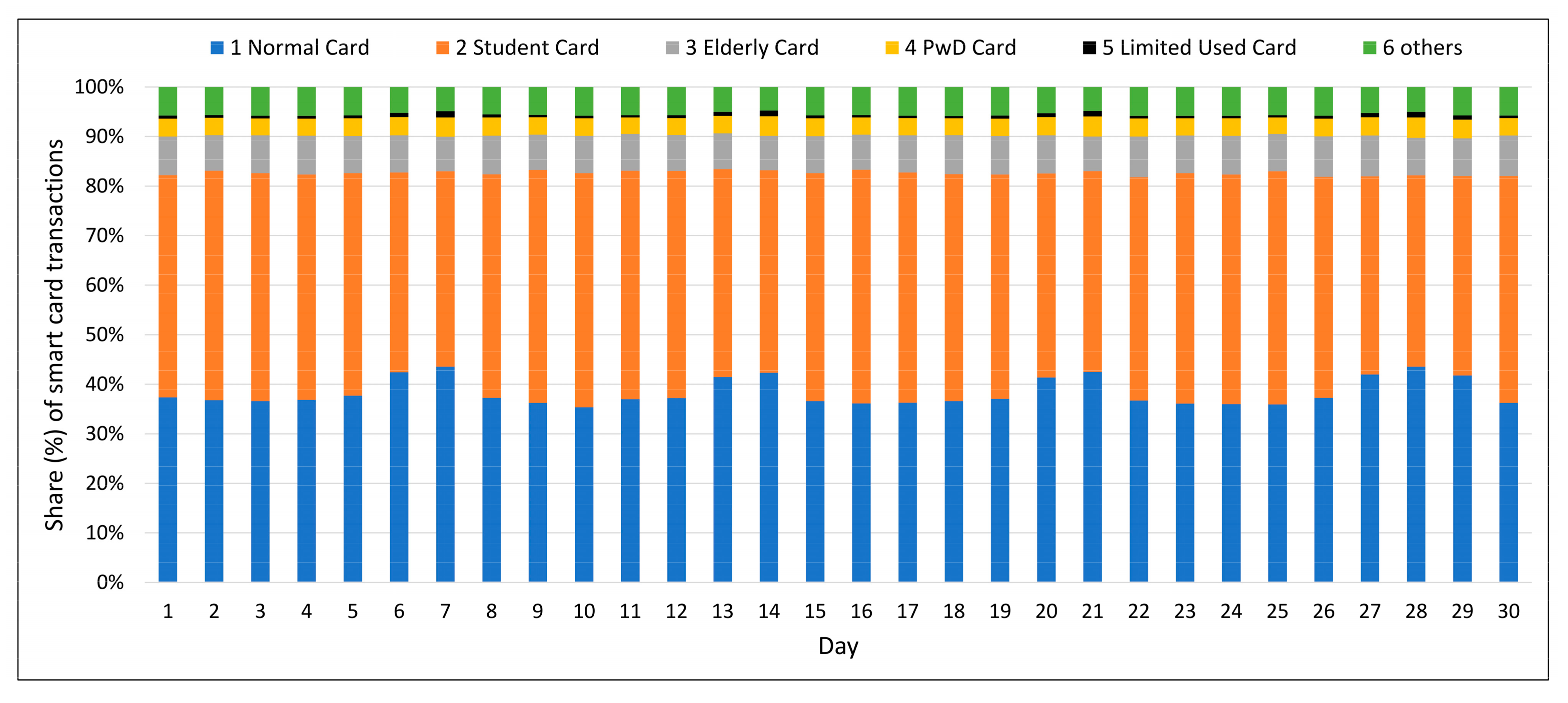




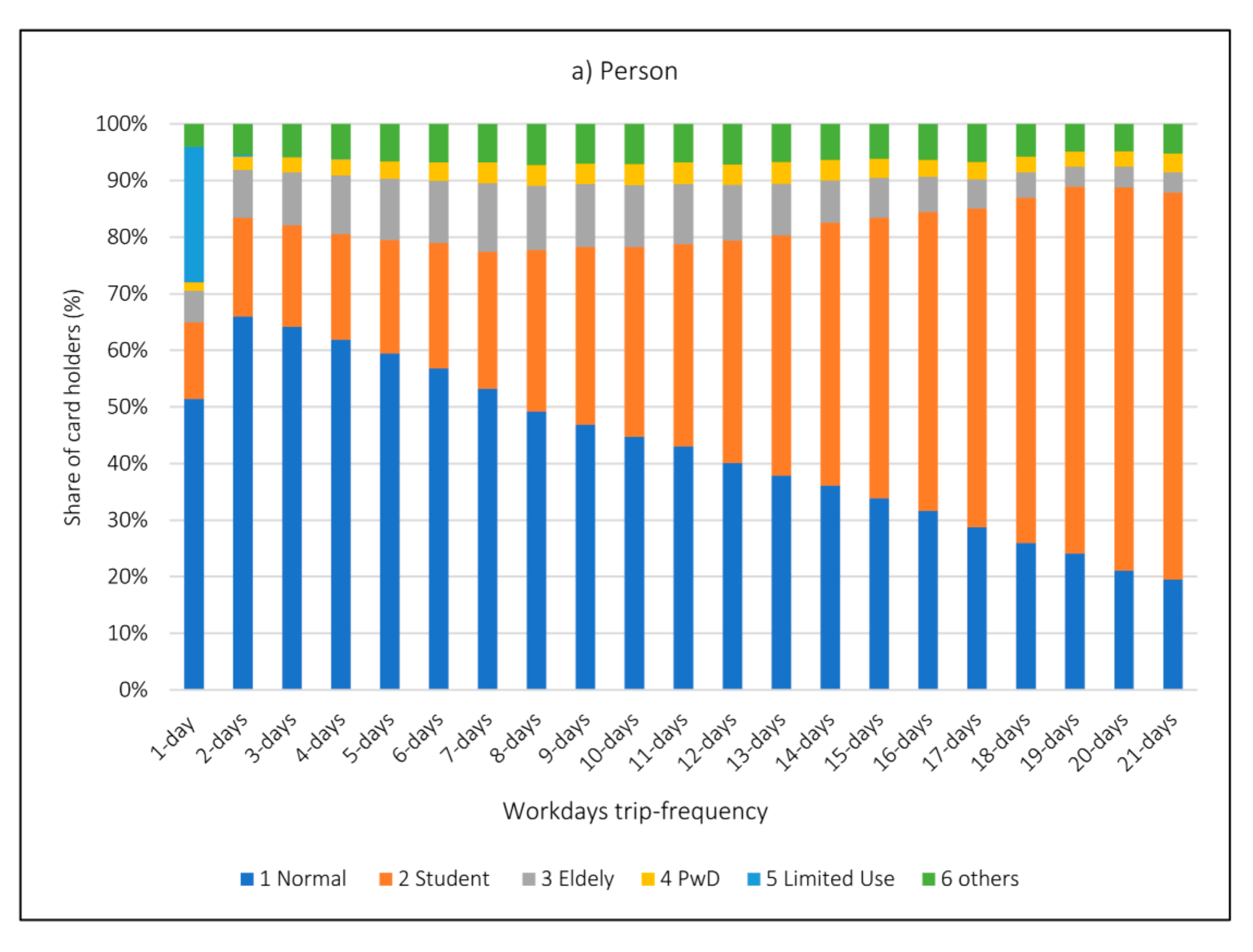
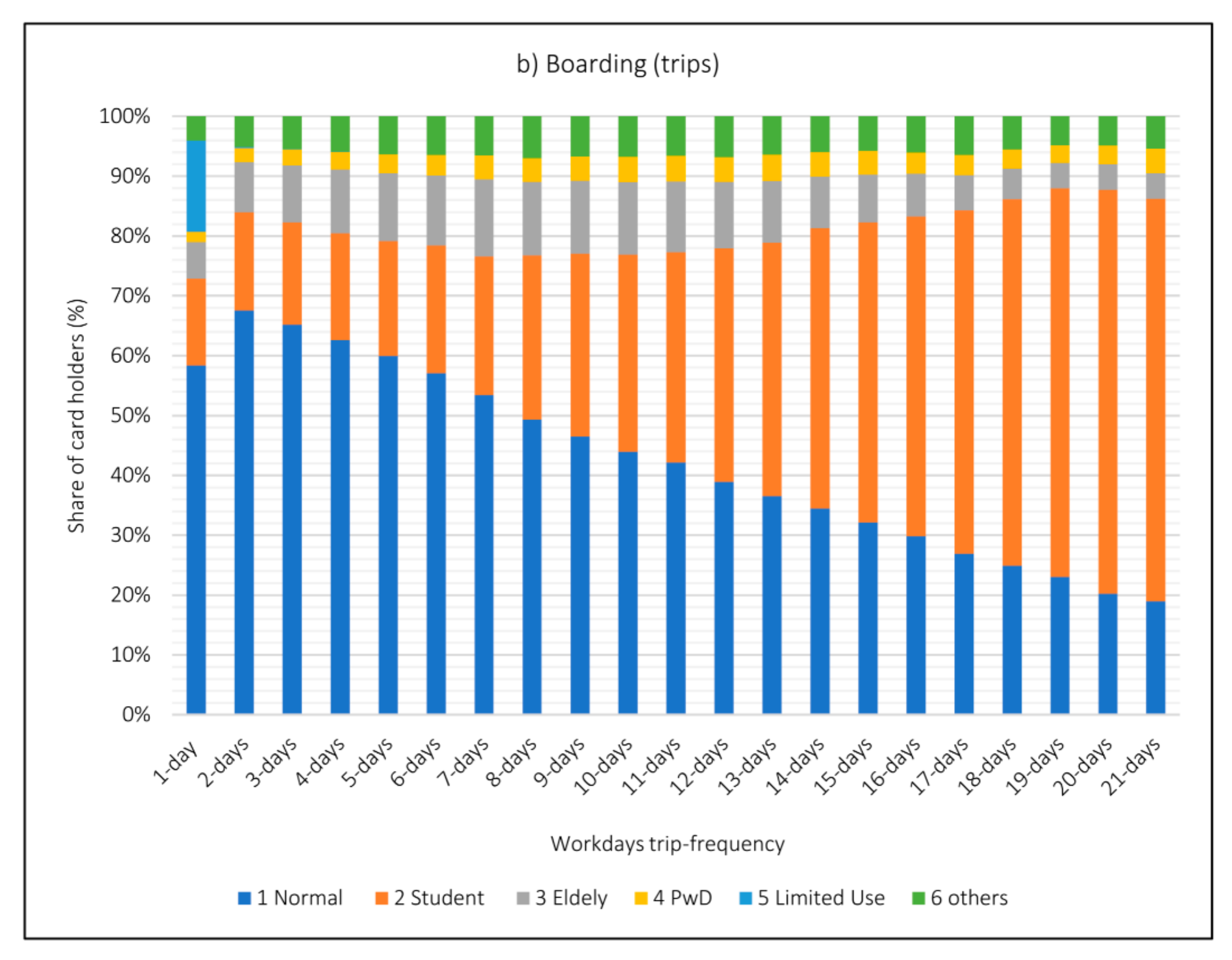

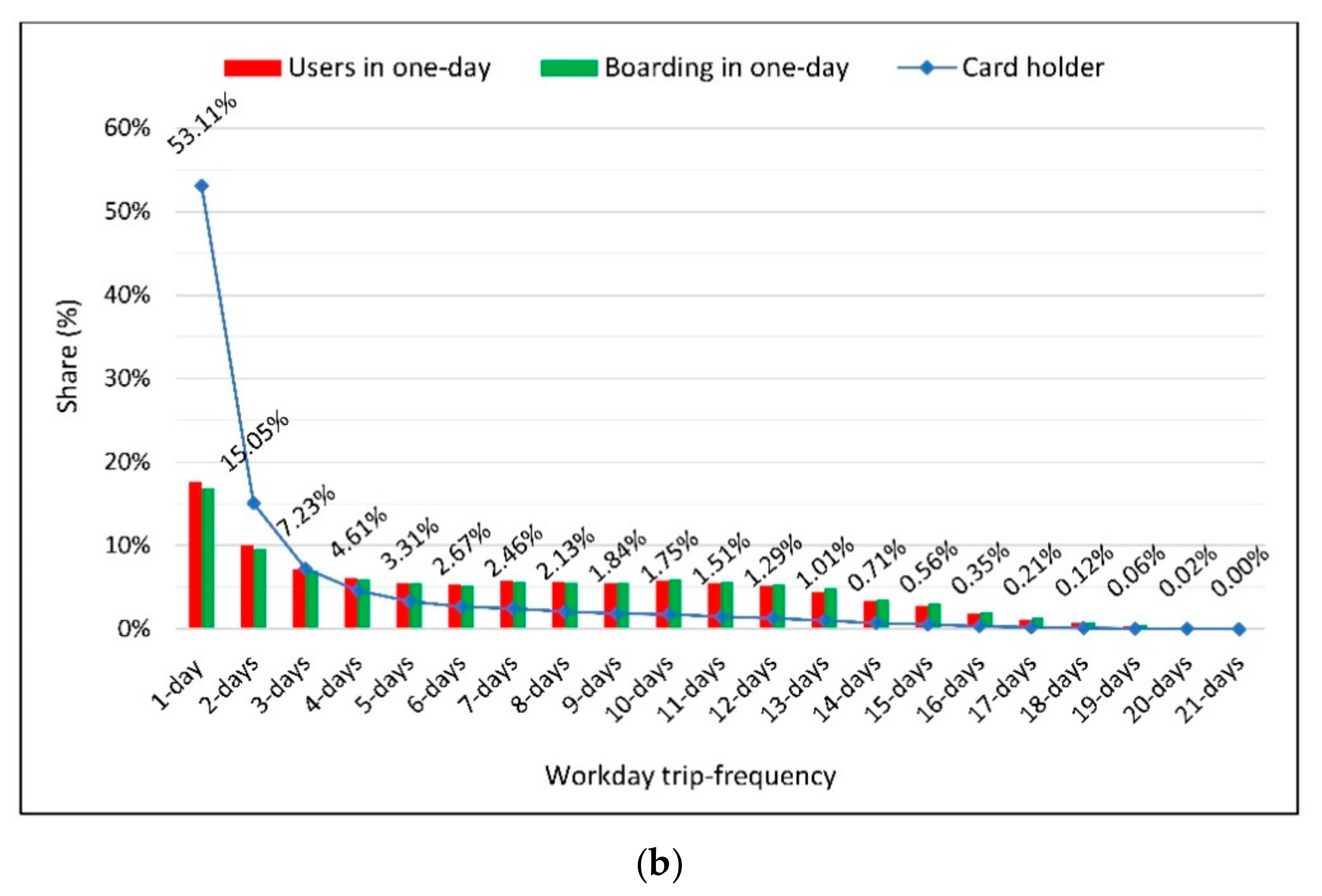
| Transportation Modes | Home-Based Work Trips | Home-Based School Trips | Home-Based Other Trips | Non-Home-Based Trips | Total Trips | |||||
|---|---|---|---|---|---|---|---|---|---|---|
| No. of Trips | % | No. of Trips | % | No. of Trips | % | No. of Trips | % | No. of Trips | % | |
| Walking | 135,085 | 21% | 539,252 | 70% | 223,257 | 27% | 76,573 | 39% | 974,168 | 40% |
| Private car | 172,874 | 21% | 29,605 | 70% | 296,496 | 27% | 66,062 | 39% | 565,037 | 23% |
| Shuttle service | 201,878 | 31% | 108,173 | 14% | 13,135 | 2% | 7397 | 4% | 330,583 | 14% |
| Public transport | 149,105 | 23% | 89,976 | 12% | 285,815 | 35% | 48,230 | 24% | 573,125 | 23% |
| Total | 658,943 | 100% | 767,005 | 100% | 818,703 | 100% | 198,262 | 100% | 2,442,913 | 100% |
| Org. Card Type | Rev. Card Type | Unique Card | # of Boarding | Org. Card Type | Rev. Card Type | Unique Card | # of Boarding |
|---|---|---|---|---|---|---|---|
| 1 | 1 | 382,442 | 2,271,551 | 73 | 6 | 564 | 6750 |
| 10 | 1 | 16,030 | 79,413 | 78 | 6 | 521 | 4307 |
| 4 | 2 | 216,333 | 2,641,065 | 76 | 6 | 306 | 3475 |
| 65 | 3 | 57,788 | 425,234 | 79 | 6 | 225 | 1687 |
| 16 | 3 | 605 | 3804 | 67 | 6 | 168 | 2798 |
| 13 | 5 | 73,333 | 73,896 | 70 | 6 | 128 | 1750 |
| 5 | 6 | 22,883 | 148,718 | 72 | 6 | 87 | 1124 |
| 6 | 6 | 9950 | 104,110 | 77 | 6 | 46 | 264 |
| 69 | 6 | 3664 | 35,078 | 66 | 6 | 2 | 13 |
| 68 | 6 | 2203 | 25,918 | 74 | 4 | 16,254 | 170,436 |
| 87 | 6 | 1855 | 14,785 | 75 | 4 | 3447 | 20,185 |
| Clustered User Groups | Boarding | Unique Card ID | Boarding Rate | |||||||||
|---|---|---|---|---|---|---|---|---|---|---|---|---|
| Workday | STD | Weekend | STD | Workday | STD | Weekend | STD | Workday | STD | Weekend | STD | |
| 1: Normal | 36.6% | 0.6% | 42.3% | 0.8% | 38.0% | 0.5% | 42.2% | 0.4% | 1.96 | 0.01 | 2.01 | 0.04 |
| 2: Student | 45.9% | 0.8% | 40.3% | 1.0% | 44.9% | 0.7% | 39.7% | 0.8% | 2.08 | 0.02 | 2.04 | 0.03 |
| 3: Elderly | 7.7% | 0.3% | 7.4% | 0.4% | 7.0% | 0.3% | 7.3% | 0.3% | 2.21 | 0.03 | 2.04 | 0.05 |
| 4: PwD | 3.5% | 0.1% | 3.8% | 0.2% | 3.1% | 0.1% | 3.5% | 0.2% | 2.31 | 0.02 | 2.19 | 0.02 |
| 5: Limited Use | 0.5% | 0.1% | 1.0% | 0.2% | 1.0% | 0.1% | 1.9% | 0.3% | 1.04 | 0.01 | 1.03 | 0.01 |
| 6: Others | 5.8% | 0.1% | 5.1% | 0.3% | 5.9% | 0.1% | 5.3% | 0.3% | 1.97 | 0.01 | 1.93 | 0.02 |
| Trip Freq. Group | Boarding | Person | ||
|---|---|---|---|---|
| Workday | SDT | Workday | SDT | |
| 1-day | 3.42% | 0.67% | 4.27% | 0.74% |
| 2-days | 3.68% | 0.37% | 4.02% | 0.38% |
| 3-days | 3.87% | 0.29% | 4.18% | 0.30% |
| 4-days | 3.84% | 0.23% | 4.11% | 0.23% |
| 5-days | 3.74% | 0.21% | 3.96% | 0.19% |
| 6-days | 3.49% | 0.13% | 3.68% | 0.13% |
| 7-days | 3.32% | 0.09% | 3.49% | 0.08% |
| 8-days | 3.24% | 0.09% | 3.36% | 0.09% |
| 9-days | 3.13% | 0.07% | 3.26% | 0.07% |
| 10-days | 3.10% | 0.08% | 3.18% | 0.09% |
| 11-days | 2.98% | 0.12% | 3.08% | 0.12% |
| 12-days | 2.98% | 0.14% | 3.06% | 0.15% |
| 13-days | 3.14% | 0.16% | 3.18% | 0.17% |
| 14-days | 3.26% | 0.20% | 3.29% | 0.19% |
| 15-days | 3.69% | 0.23% | 3.67% | 0.22% |
| 16-days | 4.19% | 0.25% | 4.12% | 0.23% |
| 17-days | 4.90% | 0.24% | 4.78% | 0.23% |
| 18-days | 5.95% | 0.22% | 5.74% | 0.22% |
| 19-days | 7.36% | 0.20% | 7.07% | 0.20% |
| 20-days | 10.18% | 0.20% | 9.54% | 0.19% |
| 21-days | 16.56% | 0.21% | 14.95% | 0.18% |
| Card Type | Bus Line No. 23 | Bus Line No. 118 | ||||
|---|---|---|---|---|---|---|
| Person Day | TRIP DAY | Real # of Users | Person Day | Trip Day | Real # of Users | |
| 1 Normal | 23.3% | 24.4% | 34.0% | 50.1% | 52.5% | 55.7% |
| 2 Students | 70.7% | 70.1% | 56.8% | 32.5% | 31.1% | 25.4% |
| 3 Elderly | 2.3% | 2.1% | 4.0% | 9.1% | 8.6% | 10.5% |
| 4 PwD | 1.2% | 1.1% | 1.6% | 3.4% | 3.3% | 3.1% |
| 5 Limited Use | 0.1% | 0.1% | 0.4% | 0.1% | 0.1% | 0.3% |
| 6 Others | 2.3% | 2.1% | 3.4% | 4.8% | 4.4% | 5.1% |
Publisher’s Note: MDPI stays neutral with regard to jurisdictional claims in published maps and institutional affiliations. |
© 2021 by the authors. Licensee MDPI, Basel, Switzerland. This article is an open access article distributed under the terms and conditions of the Creative Commons Attribution (CC BY) license (https://creativecommons.org/licenses/by/4.0/).
Share and Cite
Ghasemlou, K.; Ergun, M.; Dadashzadeh, N. Exploring Equity in Public Transportation Planning Using Smart Card Data. Sensors 2021, 21, 3039. https://doi.org/10.3390/s21093039
Ghasemlou K, Ergun M, Dadashzadeh N. Exploring Equity in Public Transportation Planning Using Smart Card Data. Sensors. 2021; 21(9):3039. https://doi.org/10.3390/s21093039
Chicago/Turabian StyleGhasemlou, Kiarash, Murat Ergun, and Nima Dadashzadeh. 2021. "Exploring Equity in Public Transportation Planning Using Smart Card Data" Sensors 21, no. 9: 3039. https://doi.org/10.3390/s21093039
APA StyleGhasemlou, K., Ergun, M., & Dadashzadeh, N. (2021). Exploring Equity in Public Transportation Planning Using Smart Card Data. Sensors, 21(9), 3039. https://doi.org/10.3390/s21093039







